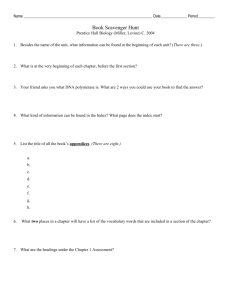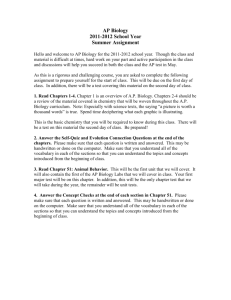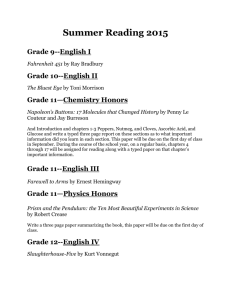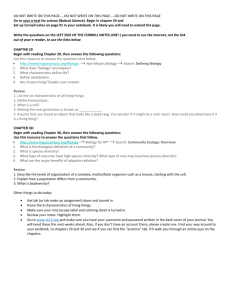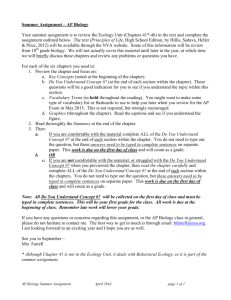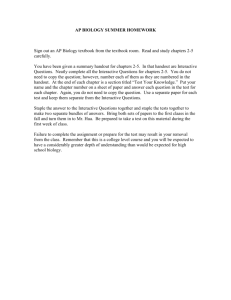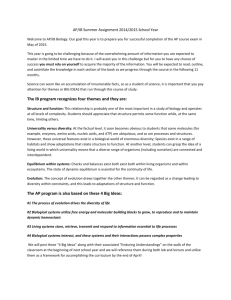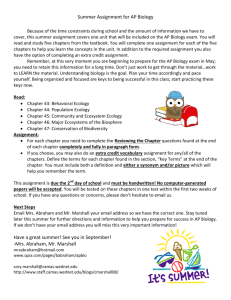Honors Biology Summer Assignment 2014 - 2015
advertisement
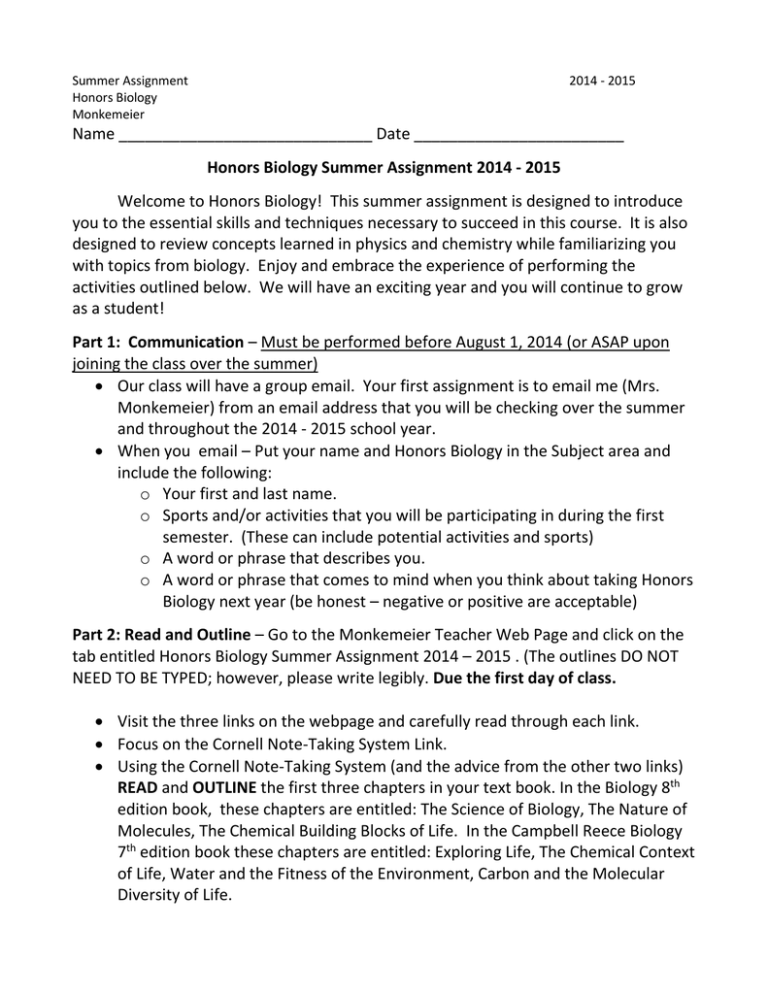
Summer Assignment Honors Biology Monkemeier 2014 - 2015 Name _____________________________ Date ________________________ Honors Biology Summer Assignment 2014 - 2015 Welcome to Honors Biology! This summer assignment is designed to introduce you to the essential skills and techniques necessary to succeed in this course. It is also designed to review concepts learned in physics and chemistry while familiarizing you with topics from biology. Enjoy and embrace the experience of performing the activities outlined below. We will have an exciting year and you will continue to grow as a student! Part 1: Communication – Must be performed before August 1, 2014 (or ASAP upon joining the class over the summer) Our class will have a group email. Your first assignment is to email me (Mrs. Monkemeier) from an email address that you will be checking over the summer and throughout the 2014 - 2015 school year. When you email – Put your name and Honors Biology in the Subject area and include the following: o Your first and last name. o Sports and/or activities that you will be participating in during the first semester. (These can include potential activities and sports) o A word or phrase that describes you. o A word or phrase that comes to mind when you think about taking Honors Biology next year (be honest – negative or positive are acceptable) Part 2: Read and Outline – Go to the Monkemeier Teacher Web Page and click on the tab entitled Honors Biology Summer Assignment 2014 – 2015 . (The outlines DO NOT NEED TO BE TYPED; however, please write legibly. Due the first day of class. Visit the three links on the webpage and carefully read through each link. Focus on the Cornell Note-Taking System Link. Using the Cornell Note-Taking System (and the advice from the other two links) READ and OUTLINE the first three chapters in your text book. In the Biology 8th edition book, these chapters are entitled: The Science of Biology, The Nature of Molecules, The Chemical Building Blocks of Life. In the Campbell Reece Biology 7th edition book these chapters are entitled: Exploring Life, The Chemical Context of Life, Water and the Fitness of the Environment, Carbon and the Molecular Diversity of Life. A Template for note – taking is available on the Webpage below the link OR you can Xerox copies of the template attached. FEEL FREE to modify the template to your style so long as it includes the components on the template. Your outlines of the three chapters will be checked within the first week of school. These outlines will be part of your Summer Assignment Grade. You will be required to use the Cornell Note-Taking System throughout the course as we explore new chapters. Don’t worry – this system will become second nature to you and you will wonder how you survived without it. During the year – we will have notebook checks and you will be given credit for you reading notes. Part 3: Review and Comprehension – Due the first day of class. After completing Part 2, answer the following questions below using complete sentences. (Typed on a separate sheet of paper) 1. Why does life defy simple definition? What characteristics describe life and/or organisms? 2. Describe the way that living systems are organized. 3. Compare and contrast inductive reasoning with deductive reasoning and provide examples of each type of reasoning. 4. Compare and contrast geometric progression with arithmetic progression. What is the effect of reducing the constant factor by which the geometric progression increases? Might this effect be achieved with humans? How? 5. List and describe the Unifying Themes in Biology. 6. Explain how atomic structure is related to the following terms: isotopes and ions. 7. Explain why isotopes are important in the study of biology by providing examples of their relevance and use. 8. Which elements from the Periodic Table are found in living systems in more than trace amounts? Of those elements just listed, which elements are considered to be part of the basic building blocks of life? 9. Energy flows through living systems in a series of oxidations and reductions. WHY is this the most advantageous way for living systems to transfer energy? What role to chemical bonds and electrons play in these Redox reactions? 10. The Redox reactions are controlled by organic catalysts known as enzymes. What is the role of a catalyst? WHY is it important that a catalyst is recycled and not altered by performing its role? How can the availability of a catalyst be used to control chemical reaction pathways? 11.Completely explain the structure of a water molecule and how it relates to the polar nature of water. 12.Explain the following properties of water contribute to the well-being of organisms: high specific heat, high heat of vaporization, the ability to form ions. 13.How does water organize nonpolar molecules and why is this important to organisms. Give a specific example of how water contributes to the organization of living systems. 14.WHY is pH important to living systems and specifically, how does pH affect the rate of chemical reactions? 15.Biological molecules can be built or broken down using two essential chemical reactions. List and describe these two chemical reactions. 16.WHY is carbon the essential element for building carbohydrates, lipids, proteins and nucleic acids? 17.Functional groups provide a hydrocarbon with “personality”. What does this mean? What is a functional group and how are they recognized? 18.Why are isomers important to the study of Biological molecules? Which categories of biological molecules contain isomers that are well-known? Provide specific examples. 19.Hydrogen bonds play an important role in stabilizing and organizing biological molecules. Consider the four macromolecules (carbohydrates, lipids, proteins and nucleic acids), describe three examples where hydrogen bond formation affects the form or function of the macromolecule. 20.How do the four biological macromolecules differ from one another? Refer to the diagram of monomer structure n figure 3.3 and summarize what “clues” you use to distinguish between these macromolecules. Part 4: Comprehension Due the first day of class. Perform the Self Test - Multiple Choice Questions at the end of each of the chapters listed for your particular text book. Notes: We will be having a Unit 1 Test (First three chapters) within the first three cycles of school. Safety and Lab Safety will be discussed within the first double lab period and a all students will be required to pass a Lab Safety and Lab Technique Test prior to performing the first official lab in Honors Biology. See the Lab Safety Tabs on Monkemeier Web Page as well as the Flinn Lab Safety Contract Tab. Parts 2 – 4 of the Summer Assignment are due on the first day of school. See Grading Rubric Below. Grading Rubric For Honors Biology Summer Assignment Part 1: Communication 5 Points 3 Points 1 Point 0 Points Email received prior to 8/1 with all directions followed. Email received prior to 8/1 but some information missing Email received after 8/1 with some information missing. Email not received. Cornell- Note Taking System Followed and All Three Chapters outlined completely according to System. All 20 questions answered in complete sentences and typed. Answers to Questions demonstrate effort and comprehension of concepts. Cornell- Note Taking System Followed but information from chapters missing. 5% of grade Part 2: Read and Outline Part 3: Review and Comprehension Part 4: Comprehension Timing All 44 multiple choice questions answered and directions followed. More than 80% of answers correct. All Parts 2 – 4 turned in on the first day of school – on time Chapters Outlines of all outlined but three chapters either Cornell not System not completed followed and/or information from chapters missing. Some questions All 20 questions missing/ not answered but answered in /not in complete complete sentences and sentences/ /or not typed./or answers do not Answers demonstrate demonstrate effort, attention to some effort but detail or not complete comprehension comprehension of concepts. All 44 multiple All 44 multiple choice questions choice questions answered and all answered and all directions directions followed. 70% of followed. 50% of answers correct. answers correct. All Parts 2-4 turned in after first day but within the first week of school. All Parts 2-4 turned in after first day but within the second week of school Directions not followed and/or more than 5 questions unanswered. 44 multiple choice questions not turned in. All Parts 2-4 turned in after first day and after third week of school Honors Biology Cornell Note-Taking Template Chapter _____________________ Name: _______________________________________________________ Section Title: _________________ Pages _______________________ In this left column: Turn the Headings of each section into questions. Summary Date: ________________________________________________________ In this right column Remember - Vocabulary with definitions that relate to question Cite Evidence or ideas to answer the question.
